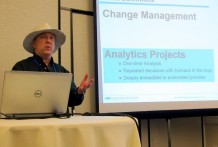QuadGraphics, www.qg.com, an NYSE company, is the second largest print and integrated media solutions provider in North America. The firm’s leaders have consistently emphasized improving performance through innovation and, as evidence of that commitment, they invited us several years ago to look for optimization opportunities at their organization.
First, they showed us the printing presses, their most valuable asset. When our team looked at the presses, we literally could find nothing to help them with—mainly because all the jobs were designed to fit exactly on those presses, to not waste paper, to be efficient as possible.
However, we were happy to find was there was another area where we could help: the binding lines.



